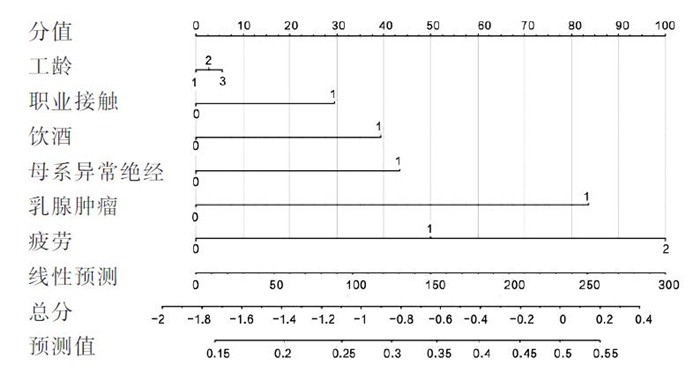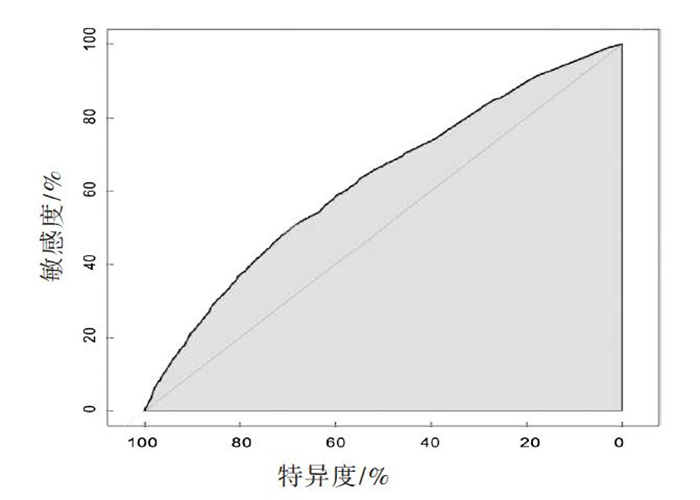Analysis of the influencing factors and risk nomogram model of reproductive tract infection of female workers in petrochemical industry
-
+ English摘要:目的 建立石油化工企业女性职工生殖道感染风险的列线图模型,分析该行业女工生殖健康的影响因素。方法 选择某石油化工企业所有的5 186名女性职工作为研究对象,进行现场和问卷调查,分析石油化工企业的职业病危害因素,以及女性职工的疲劳情况和生殖道感染发生率,并采用多因素logistic回归和列线图预测模型揭示生殖道感染的危险因素和影响程度。结果 共发放问卷5 186份,回收有效问卷5 132份,问卷有效率为98.96%。该大型国有石油化工企业主要职业病危害因素包括有机溶剂、粉尘、有毒气体、电磁辐射、噪声等。调查女工中近6个月内存在生殖道感染的1 241人(占24.18%)。logistic回归分析结果显示:工龄10 ~ 19年、职业接触有害因素、有饮酒习惯、母系亲属存在过早或过晚绝经、患有乳腺肿瘤、存在躯体疲劳以及脑力疲劳是女工出现生殖道感染的危险因素(OR =1.300、1.220、1.363、1.384、1.864、1.515、2.049,P < 0.05)。基于多因素回归结果建立的石油化工行业女工生殖道感染的列线图模型的C-index指数为0.626(95%CI为0.608 ~ 0.644)。结论 石油化工行业女工生殖道健康受不良生活方式、遗传、职业有害因素接触、疲劳程度等多种因素影响;建立的列线图预测模型有良好的精准度和区分度,有助于提高石化行业女工的生殖健康风险的评估效能。应采取针对性的管理措施、预防手段和职业健康教育来降低女工生殖道感染的患病水平,促进石油化工行业女工的职业健康。
-
工作相关肌肉骨骼疾患(work-related musculoskeletal disorders,WMSDs)是由职业活动直接或间接引起的肌肉、神经、肌腱、关节或椎间盘等组织的损伤或疾患,其主要体征和症状是疼痛、感觉异常、疲劳和活动受限等。WMSDs几乎可发生于各行业,但由于工作性质、行业特点不同,并伴随着科技发展和生产方式转变,不同行业WMSDs发生状况也大不相同。贾宁等 [1]在2018—2020年对中国15个重点行业职业群体的大样本调查中发现,21 560名汽车制造业劳动者中,腕/手部WMSDs的发生率为14.9%,标化发生率为14.0%。虽然腕/手部疾患不像颈部、下背部、肩部那么常见,但手的功能直接影响工人的劳动能力,该部位的疾患对患者工作、生活都会造成极大的困扰。腕/手部WMSDs的典型疾病——腕管综合征,是工作相关上肢疾患中治疗费用最多、引起缺勤时间最长的病种,也是企业支付赔偿金的主要原因之一 [2]。汽车制造企业作为北京市重点行业之一,广泛存在低负荷、快节奏、高重复、强迫体位等腕/手部WMSDs相关的不良工效学问题 [3]。目前对于北京市汽车制造业的腕/手部WMSDs研究较少,因此,本研究对北京市某汽车制造业一线劳动者腕/手部肌肉骨骼疾患及其影响因素进行了调查,以期为预防汽车制造业劳动者预防腕/手部WMSDs的发生提供科学依据。
1. 对象与方法
1.1 对象
采用方便抽样方法,于2023年8—10月选择在北京市某汽车制造企业的总装车间和焊接车间的全部一线劳动者为研究对象,该企业班制均为长白班。本研究发放调查问卷648份,回收有效问卷591份,有效问卷回收率为91.2%。纳入标准:年龄≥ 18岁,本岗位工龄≥ 1年,知情同意参与本次调查;既往无外伤、先天性肌肉骨骼疾患以及因其他疾患(如风湿性关节炎等)导致肌肉骨骼损伤者。此次调查已通过中国疾病预防控制中心伦理审查委员会的审查,研究对象均已签署知情同意书。
1.2 方法
1.2.1 WMSDs调查
《中文版肌肉骨骼疾患问卷》 [1]以北欧肌肉骨骼疾患调查问卷(Nordic Musculoskeletal Questionnaires,NMQ)和荷兰肌肉骨骼疾患调查问卷 [2]为基础,经适当修改后,被证实具有良好的信度和效度,可用于中国职业人群。调查内容包括:(1)一般人口学特征:性别、年龄、身高、体重、文化程度、体育锻炼、工龄、外伤史和既往病史等;(2)过去1年内不同身体部位的WMSDs患病情况。WMSDs判定参考美国国家职业安全卫生研究所对肌肉骨骼疾患的判定标准 [4],本研究中的WMSDs是指出现疼、痛、僵硬、烧灼感、麻木或刺痛等不适症状,同时满足以下条件:①过去12月内不适;②从事当前工作后出现不适;③既往无事故或突发伤害;④每月均出现不适症状或持续出现的时间 > 7 d,则判定该部位存在肌肉骨骼疾患。某部位WMSDs患病率指某部位罹患WMSDs的人数占总调查人数的百分比。
1.2.2 职业因素调查
采用本课题组编制的《职业健康调查问卷》进行调查,内容包括工作情况、工作姿势、用力负荷、劳动组织、工作环境等情况。指标定义:体重指数(body mass index,BMI)=体重/身高2(单位为kg/m2):正常范围为18.5 ~ 23.9 kg/m2, < 18.5 kg/m2为偏低,24.0 ~ 27.9 kg/m2为超重,≥ 28.0 kg/m2为肥胖 [5]。体育锻炼指每次锻炼持续时间≥ 30 min或流汗 [6]。本工种工龄指截至进入本研究时从事当前工种的工龄。
1.2.3 疲劳感觉调查
首先采用主诉下班后疲劳感觉的方式判定研究对象是否存在作业疲劳情况,再通过《Borg 6-20主观疲劳等级(Borg 6-20 rating of perceived exertion,RPE)量表》 [7]对研究对象全身整体作业疲劳程度进行评估。该量表以RPE得分6 ~ 20分代表由“无疲劳”到“精疲力竭”的自觉作业疲劳程度。本研究中下班后疲劳感觉按照RPE得分划分为以下4组:RPE得分≤ 12分为无疲劳,13 ~ 14分为稍疲劳,15 ~ 16分为疲劳,≥ 17分为非常疲劳。
1.2.4 质量控制
正式调查前进行小样本预调查。调查前统一培训调查人员,调查时由调查人员统一讲解调查内容与填写要求及注意事项。调查采用电子问卷的形式,电子问卷设置有自动逻辑纠错功能,可避免不合理信息,以确保问卷的真实性、完整性及较高的回收率。
1.2.5 统计学分析
采用SPSS 26.0软件进行统计学分析。计量资料经正态性检验符合正态分布者采用均数和标准差(x ± s)描述,不符合正态分布者用中位数和四分位位数[M(P25,P75)]描述;计数资料采用率或构成比描述。计数资料组间比较采用Pearson χ2检验或Fisher确切概率法。影响因素分析采用多因素logistic回归分析(向前法,纳入水准为0.05,剔除水准为0.10)。检验水准α = 0.05(双侧)。
2. 结果
2.1 基本情况
591名研究对象中焊接车间197人,总装车间394人;男性547人,女性44人;大学本科以下537人,大学本科及以上54人;平均年龄为(34.82 ± 6.51)岁;本工种平均工龄为(7.96 ± 4.95)年,平均总工龄为(13.25 ± 6.41)年;BMI为(26.03 ± 10.68)kg/m2;下班后稍疲劳356人,疲劳和非常疲劳各79、68人。详见表 1。
表 1 不同个体特征劳动者腕/手部肌肉骨骼疾患患病情况[人数(占比/%)] 分组 调查人数 WMSDs χ2值 P值 车间 < 0.001 >0.999 焊接车间 197(33.33) 16(8.12) 总装车间 394(66.67) 32(8.12) 性别 2.180 0.140 男 547(92.55) 47(8.59) 女 44(7.45) 1(2.27) 年龄/岁 3.362 0.186 < 30 135(22.84) 6(4.44) 30 ~ 40 324(54.82) 31(9.57) > 40 132(22.34) 11(8.33) 工龄/年 0.355 0.949 < 5 160(27.07) 14(8.75) 5 ~ 9 262(44.33) 22(8.40) 10 ~ 15 155(26.23) 11(7.10) > 15 14(2.37) 1(7.14) 总工龄/年 2.853 0.415 < 5 68(11.51) 5(7.35) 5 ~ 9 136(23.01) 9(6.62) 10 ~ 15 146(24.70) 9(6.16) > 15 241(40.78) 25(10.37) BMI 1.770 0.621 低体重 17(2.88) 2(11.76) 正常 232(39.25) 18(7.76) 超重 207(35.02) 14(6.76) 肥胖 135(22.84) 14(10.37) 学历 0.525 0.469 大学本科以下 537(90.86) 45(8.38) 大学本科及以上 54(9.14) 3(5.56) 惯用手 0.586 0.746 左手 69(11.68) 4(5.80) 右手 423(71.57) 36(8.51) 双手 99(16.75) 8(8.08) 体育锻炼 3.676 0.452 从不 263(44.50) 27(10.27) 1 ~ 3次/季度 85(14.38) 7(8.24) 2 ~ 3次/月 80(13.54) 5(6.25) 1 ~ 2次/周 119(20.14) 7(5.88) > 2次/周 44(7.45) 2(4.55) 下班后疲劳感觉 11.889 0.008 无疲劳 88(14.89) 3(3.41) 稍疲劳 356(60.24) 25(7.02) 疲劳 79(13.37) 8(10.13) 非常疲劳 68(11.51) 12(17.65) 工作中腕部屈曲、伸展、侧弯或旋转 25.839 < 0.001 是 297(50.25) 41(13.80) 否 294(49.75) 7(2.38) 工具、手持设备或工件不易拿握 19.345 < 0.001 是 133(22.50) 23(17.29) 否 458(77.50) 25(5.46) 使用工具或物品时手用力情况 7.956 0.093 力量极低/低(15%最大力量) 231(39.09) 12(5.19) 力量中等(30%最大力量) 215(36.38) 20(9.30) 力量高(50%最大力量) 98(16.58) 9(9.18) 力量极高(80%最大力量) 22(3.72) 2(9.09) 力量达到峰值(> 80%最大力量) 25(4.23) 5(20.00) 在工作时,手一般保持高度 9.155 0.002 肩或肩以下 420(71.07) 25(5.95) 肩以上 171(28.93) 23(13.45) 工作中手臂上下左右移动的发生频率 4.888 0.087 低(< 10次/min) 347(58.71) 21(6.05) 中(10 ~ 20次/min) 176(29.78) 19(10.80) 高(> 20次/min) 68(11.51) 8(11.76) 手部抓握质量/kg 1.699 0.637 < 5 394(66.67) 28(7.11) 5 ~ 10 97(16.41) 10(10.31) 11 ~ 15 45(7.61) 4(8.89) > 15 55(9.31) 6(10.91) 经常搬运> 5 kg的物体 3.418 0.064 是 166(28.09) 19(11.45) 否 425(71.91) 29(6.82) 每天工作多久后休息(不含午休)/h 2.878 0.579 < 1 47(7.95) 2(4.26) 1 ~ < 2 158(26.73) 12(7.59) 2 ~ < 3 297(50.25) 29(9.76) 3 ~ < 4 41(6.94) 2(4.88) ≥ 4 48(8.12) 3(6.25) 工作能否顺利跟上工作节奏 4.237 0.120 能 454(76.82) 31(6.83) 有时难以跟上 125(21.15) 16(12.80) 经常难以跟上 12(2.03) 1(8.33) 工作场所地面不平、湿滑、倾斜 1.920 0.166 是 94(15.91) 11(11.70) 否 497(84.09) 37(7.44) 空间受限而以不舒适的姿势工作 3.013 0.083 是 116(19.63) 14(12.07) 否 475(80.37) 34(7.16) 在低温环境下工作或处理低温物料 0.353 0.552 是 131(22.17) 9(6.87) 否 460(77.83) 39(8.48) 对工作区域照明的感受 10.644 0.001 太亮刺眼/光线暗淡 125(21.15) 19(15.20) 舒适 466(78.85) 29(6.22) 2.2 腕/手部WMSDs报告情况
研究对象腕/手部WMSDs症状患病率为8.1%(48/591)。单因素分析发现,下班后疲劳感觉,工作中腕部是否发生屈曲、伸展、侧弯或旋转,工具、手持设备或工件是否不易拿握,在工作时手是否保持在肩以下或以上,工作区域照明感受等情况不同的劳动者腕/手部WMSDs症状的患病率不同,差异有统计学意义(P<0.05)。见表 1。
2.3 腕/手部WMSDs影响因素分析
以研究对象腕/手部是否罹患WMSDs为响应变量(否= 0,是= 1),以表 1中单因素分析P < 0.15的因素为预测变量,进行多因素logistic回归分析。多重共线性诊断结果显示,各因素间容忍度均 > 0.1,方差膨胀因子均 < 10.0,各变量间的多重共线性程度不高。多因素logistic回归分析结果显示:工作中存在腕部屈曲、伸展、侧弯或旋转,工具、手持设备或工件太大或太小而不易拿握的情况时,劳动者腕/手部发生WMSDs的风险分别是不存在以上情况劳动者的5.194倍(95%CI:2.239 ~ 12.050)和2.373倍(95%CI:1.266 ~ 4.448)。见表 2。
表 2 腕/手部肌肉骨骼疾患影响因素的多因素logistic回归分析因素 偏回归系数 标准误 Waldχ2值 P值 OR(95%CI)值 工作中腕部屈曲、伸展、侧弯或旋转 否 1.00 是 1.647 0.429 14.720 < 0.001 5.194(2.239 ~ 12.050) 工具、手持设备或工件太大或太小,不易拿握 否 1.00 是 0.864 0.320 7.273 0.007 2.373(1.266 ~ 4.448) 注:预测变量赋值中,性别:男性= 1(对照),女性= 2;下班后疲劳感觉:无疲劳= 1(对照),稍疲劳= 2,疲劳= 3,非常疲劳= 4;工作中腕部屈曲、伸展、侧弯或旋转:否= 0(对照),是= 1;工具、手持设备或工件太大或太小,不易拿握:否= 0(对照),是= 1;使用工具或物品时手的用力情况:力量极低/低= 1(对照),力量中等= 2,力量高= 3,力量极高= 4,力量达到峰值= 5;工作中,手的位置一般保持在肩或肩以下= 1(对照),在肩以上= 2;工作中手臂上下左右移动的发生频率:低= 1(对照),中= 2,高= 3;经常搬运> 5 kg的物体:否= 0(对照),是= 1;工作时能顺利跟上工作节奏= 1(对照),有时难以跟上= 2,经常难以跟上= 3;工作中以不舒适的姿势工作:否= 0(对照),是= 1;对工作区域照明的感受:太亮刺眼/光线暗淡= 1(对照),舒适= 2。 3. 讨论
腕/手部损伤是上肢常见的损伤。本次研究结果显示,某汽车制造企业一线劳动者腕/手部WMSDs患病率(8.1%),低于李峥等(44.1%)[8]、徐宇萍等(15.7%)[9]、Chen等(14.9%)[10]、舒友梅等(10.1%)[11]对汽车制造业劳动者的调查结果。本研究腕/手部发生率较低的原因可能是其他部位的疼痛更为普遍,可能比上肢远端疼痛发生得更早,这会影响劳动者继续操作,而上肢远端疼痛可能需要更长的时间来发展 [2, 13]。另一个原因可能是目前职业流行病学研究中,WMSDs的判断多采用自报式的病例判定标准,导致不同研究结果之间存在差异 [2, 12-14]。
研究显示,反复和高强度的手密集型工作与腕/手部WMSDs的发生和严重程度有关。本研究多因素分析结果显示,工作时存在手腕屈曲、伸展、侧弯或旋转,以及工具、手持设备或工件太大或太小而不易拿握情况,其腕/手部发生WMSDs的可能性高。Chen等 [10]研究发现,工作时需要频繁上下弯曲手腕,劳动者手腕损伤的可能性增高(OR = 1.81;95%CI:1.84 ~ 2.11),与本研究结果相似。汽车制造业属于劳动密集型企业,在焊接和总装车间中,工人一般是在岗位原地长时间地重复工作,手腕需要频繁地运动来完成任务。在单调重复的手工装配和焊接操作中,如总装车间的底盘、分装、车门仪表等工段,除了手腕姿势的频繁运动,工人还需要重复取放工件和工具;当工件或者工具大小不合适时,就需要手用力捏住或握住物体或工具,使腕部组织和肌肉处于紧张状态。长期处于这样的工作状态,肌肉、神经和肌腱容易出现损伤。
本研究单因素分析结果显示,下班后不同疲劳感觉的劳动者腕/手部WMSDs患病率不同(P < 0.01)。姜萍等 [15]研究发现制造企业装配劳动者班后疲劳者的多部位WMSDs发生风险为非疲劳者的2.95 ~ 2.61倍。作业疲劳可导致职业人群面临较大的伤害和疾病风险 [16]。但在本次多因素分析中,未发现下班后疲劳感觉是腕/手部WMSDs的影响因素,可能原因是疲劳感是一种主观感受;另外在此次调查中,员工大多认为处在稍疲劳状态,与其他研究的分组标准存在差异。本研究未发现性别、年龄等常见的个体特征与腕/手部WMSDs间的关系,可能原因是参与调查的企业,劳动者多为男性,在生活习惯等方面类似,无法体现出这些个体特征与疾病之间的关系。后续需增加其他企业数据,来综合分析判断个体特征等因素与腕/手部WMSDs之间的关系。
综上所述,本研究发现汽车制造业一线劳动者腕/手部肌肉骨骼疾患的发生主要与腕/手部工作姿势、持续重复和局部受压等要素密切相关。建议加强劳动者工效学健康宣教,通过完善管理制度、合理布局工作站、开展操作技能和工效学培训、改善劳动者工作姿势、优化工作空间、改善工作环境等措施预防和控制WMSDs的发生。
作者声明 本文无实际或潜在的利益冲突 -
表 1 近6个月内女工生殖道感染单因素分析
影响因素 无生殖道感染 有生殖道感染 感染率/% χ2值 P值 年龄/岁 17.530 <0.001 <30 164 37 18.4 30 ~ 39 769 281 26.8 40 ~ 49 2 601 846 24.5 ≥ 50 357 77 17.7 饮酒 22.101 <0.001 无 2 378 665 21.9 有 1 513 576 27.6 母系亲属存在过早或过晚绝经 37.923 <0.001 无 2 442 657 21.2 有 1 449 584 28.7 乳腺肿瘤 14.706 <0.001 无 3 826 1 198 23.8 有 65 43 39.8 多囊卵巢综合征 10.817 0.002 无 3 863 1 219 24.0 有 28 22 44.0 子宫内膜异位症或子宫腺肌病 7.112 0.012 无 3 806 1 197 23.9 有 85 44 34.1 卵巢及子宫肿瘤 47.530 <0.001 无 3 832 1 177 23.5 有 59 64 52.0 睡眠时间/h 14.885 <0.001 >6 3 003 891 22.9 ≤ 6 888 350 28.3 工龄/年 9.706 0.008 6 ~ 9 485 122 20.1 10 ~ 19 911 331 26.7 ≥ 20 2 495 788 24.0 职业接触有害因素 28.338 <0.001 无 2 443 674 21.6 有 1 448 567 28.1 日平均工作时间/h 10.541 0.001 ≤ 8 3 496 1 074 23.5 >8 395 167 29.7 搬运重物 9.219 0.002 无 3 296 1 006 23.4 有 595 235 28.3 疲劳 132.702 <0.001 无 2 526 593 19.0 躯体疲劳 659 255 27.9 脑力疲劳 706 393 35.8 表 2 近6个月内女工生殖道感染多因素logistic回归分析
变量 B值 SE值 Wald χ2值 OR值(95%CI值) P值 工龄10 ~ 19年① 0.262 0.133 3.880 1.300(1.001 ~ 1.688) 0.049 接触职业病危害因素② 0.199 0.069 8.255 1.220(1.065 ~ 1.397) 0.004 有饮酒习惯② 0.310 0.067 21.186 1.363(1.195 ~ 1.555) <0.001 母系亲属过早或过晚绝经② 0.325 0.068 22.975 1.384(1.212 ~ 1.581) <0.001 患乳腺肿瘤② 0.623 0.207 9.090 1.864(1.244 ~ 2.795) 0.003 躯体疲劳② 0.415 0.089 21.801 1.515(1.272 ~ 1.803) <0.001 脑力疲劳② 0.717 0.083 74.070 2.049(1.740 ~ 2.412) <0.001 注:①OR值以工龄6 ~ 9年为参照组得出;②OR值以对应影响因素的“无”为参照组得出。 -
[1] 杨浩峰, 时瑛, 何华. 乌鲁木齐市石油化工行业女工职业卫生知识知晓情况调查[J]. 职业与健康, 2018, 34(21): 2959-2962. https://www.cnki.com.cn/Article/CJFDTOTAL-ZYJK201821021.htm [2] 寇振霞, 寇嘉宁, 俞文兰, 等. 石油化工行业主要职业危害现状分析[J]. 中国工业医学杂志, 2019, 32(5): 378-380. https://www.cnki.com.cn/Article/CJFDTOTAL-SOLE201905015.htm [3] 于常艳, 俞文兰, 徐茗, 等. 全国四省八个行业女职工职业模式与生殖健康相关性研究[J]. 中国工业医学杂志, 2019, 32(4): 252-255. https://www.cnki.com.cn/Article/CJFDTOTAL-SOLE201904005.htm [4] 姚斐, 房敏, 朱高峰, 等. 经穴推拿对慢性疲劳综合征FS-14与FAI评分的影响[J]. 南京中医药大学学报, 2012, 28(3): 222-224. doi: 10.3969/j.issn.1000-5005.2012.03.008 [5] 陈俐, 朱玲, 于辉兰, 等. 生殖道感染病原菌分布及影响因素分析[J]. 中华医院感染学杂志, 2018, 28(6): 915-917;925. https://www.cnki.com.cn/Article/CJFDTOTAL-ZHYY201806031.htm [6] JØRGENSEN T N. Sex disparities in the immune response[J]. Cell Immunol, 2015, 2(294): 61-62.
[7] 庞芬, 张文昌. 有机溶剂对雌(女)性生殖毒理学研究现状[J]. 海峡预防医学杂志, 2008, 14(5): 17-19. doi: 10.3969/j.issn.1007-2705.2008.05.006 [8] BALISE V D, CORNELIUS-GREEN J N, PARMENTER B, et al. Developmental exposure to a mixture of unconventional oil and gas chemicals increased risk-taking behavior, activity and energy expenditure in aged female mice after a metabolic challenge[J]. Front Endocrinol (Lausanne), 2019, 460(10): 2-13.
[9] SAPOUCKEY S A, KASSOTIS C D, NAGEL S C, et al. Prenatal exposure to unconventional oil and gas operation chemical mixtures altered mammary gland development in adult female mice[J]. Endocrinology, 2018, 159(3): 1277-1289. doi: 10.1210/en.2017-00866
[10] GIOVANNA P, MASSIMO L, SARA D T, et al. The estrogen-macrophage interplay in the homeostasis of the female reproductive tract[J]. Hum Reprod Update, 2018, 24(6): 652-672. doi: 10.1093/humupd/dmy026
[11] 梁红, 梁丹玉, 黎海红, 等. 广西10家水泥企业职业性噪声接触女工妇科疾病调查[J]. 职业与健康, 2019, 35(16): 2169-2172. https://www.cnki.com.cn/Article/CJFDTOTAL-ZYJK201916003.htm [12] 姚斌伟, 王惠, 张静, 等. 电磁波复合暴露对大鼠精子的影响研究[J]. 中国体视学与图像分析, 2018, 23(3): 235-240. https://www.cnki.com.cn/Article/CJFDTOTAL-ZTSX201803003.htm [13] KORNEEVA Y, SIMONOVA N. Analysis of psychological risks in the professional activities of oil and gas workers in the far north of the russian federation[J]. Behav Sci (Basel), 2018, 8(9): 2-8.
[14] 熊若虹. 运动性疲劳对雌性大鼠生殖系统和骨质损伤分子机制的初步探讨[D]. 成都: 四川大学, 2007. [15] 田慧源, 李立, 付强, 等. 肝血管肉瘤预后特征及列线图的建立与验证[J]. 中国循证医学杂志, 2020, 20(4): 395-402. https://www.cnki.com.cn/Article/CJFDTOTAL-ZZXZ202004006.htm -
期刊类型引用(2)
1. 石美华. 急诊护理流程优化对急诊患者抢救效率的影响. 中国医药指南. 2023(01): 22-25 .  百度学术
百度学术
2. 杨凤巧,李小勤,吴茵. 急救创伤专科护士核心能力评价指标体系的构建. 中华现代护理杂志. 2023(31): 4303-4309 .  百度学术
百度学术
其他类型引用(5)





 下载:
下载:


